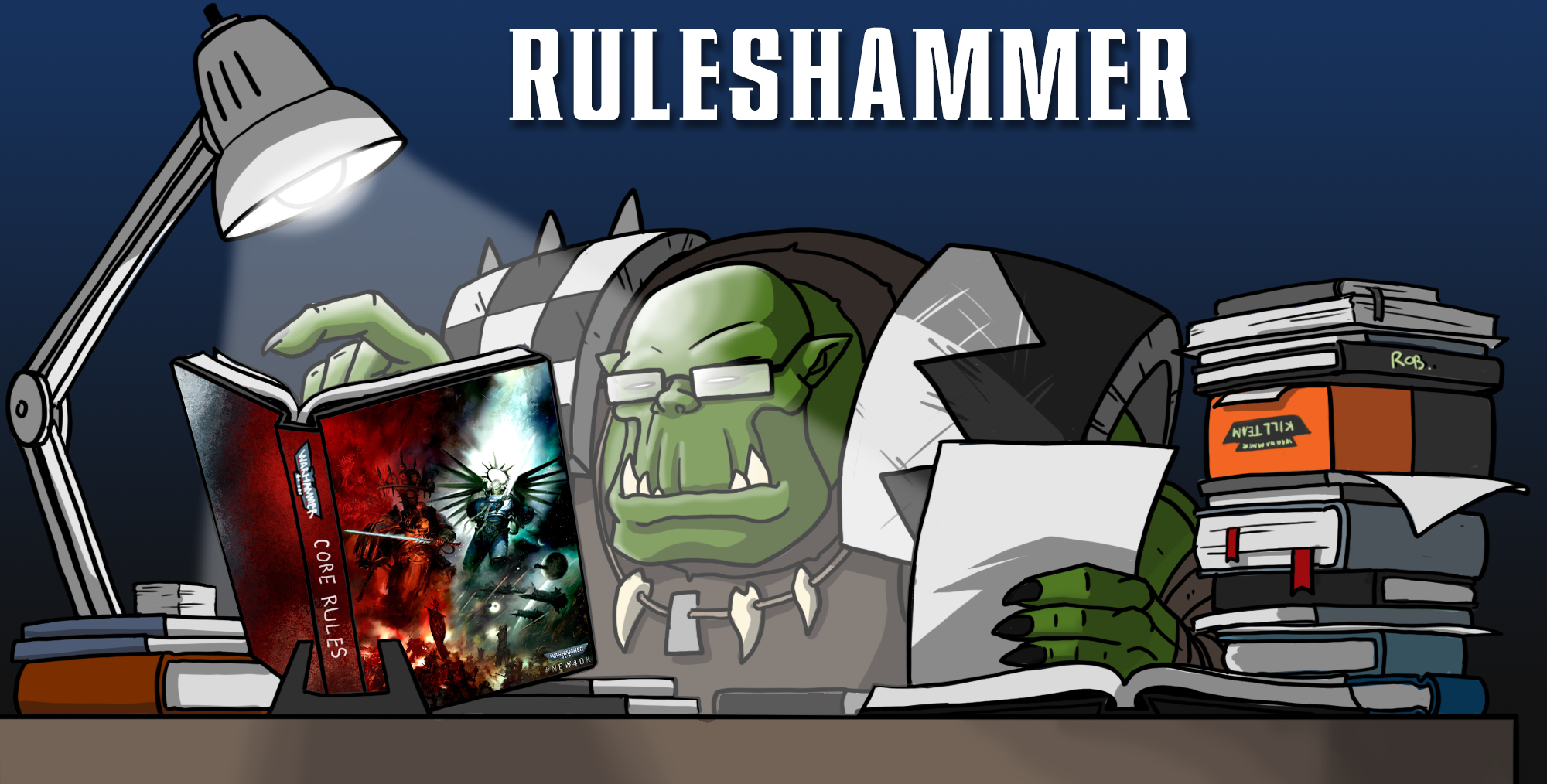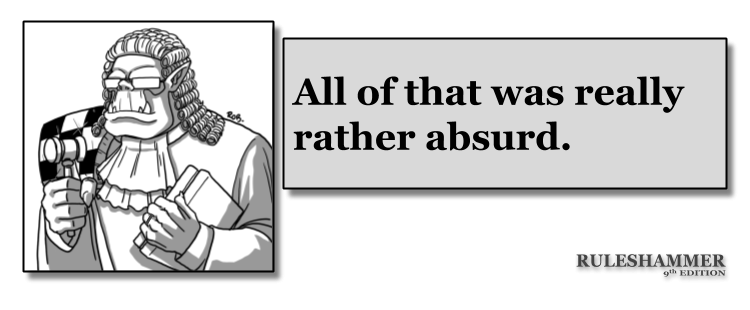GW released a bombshell of new FAQs today, covering updates to the GT missions, points updates, and rules clarifications and errata. And as always, we’ve got you covered with the rundown of what’s changed and what it means for your games. In this series of Hot Take articles, we’ll be covering the changes and our initial reactions to them but for more detailed analysis, check back over the next two weeks as we dive deeper into how these changes affect the game and its factions.
Alongside updates to the GT Missions pack, faction rules and errata, and points for nearly every faction in the game, GW also released a series of errata, clarifications, and updates for the game’s core rules. Many of these help resolve long-standing issues around topics that we’ve covered in Ruleshammer more than once and argued about in the Goonhammer Discord more than a dozen times, so it’s good to finally see them addressed. That said, there’s a lot of them. In this article, Ruleshammer Guru Rob “Vre’kais” Chilton and rules apprentice James “One Wing” Grover are covering these changes and what they mean for the game.
Clarifications and Changes
Unspecified Move Type Abilities
“Move normally: Rules that refer to move/moves/moving normally are the same thing as making a Normal Move, e.g. a rule that states ‘instead of moving this unit normally’ means ‘instead of making a Normal Move with this unit’. If a rule simply tells you to make a move as if it were the Movement phase, but does not specify what kind of move is being made, it is a Normal Move.”
[Core Book FAQ pg.7]
This rule is largely here to help out with “move as if it were the movement phase” effects that are held over from 8th, as most such abilities in the new Codexes make sure to specify a move type. This ensures that you’re never making an “untyped” move, which causes all sorts of weird breakdowns in the rules engine, something that should be avoided at all costs. It does also have some direct impact on a few abilities, largely centred around the various movement tricks Eldar can pull off.
On the positive side, this puts to bed a debate that’s been running since the start of 9th as to whether you can use Fire and Fade to mount up in to a transport – this makes it clear that you can, and there’s even an additional designers note explicitly stating that out of phase moves can allow you to board transports now (which they couldn’t in 8th).
“We wish to add an example to explain how the Out of Phase rules apply to units. When a unit uses a rule to make a move as if it were the Movement phase, all the normal rules that would apply in the Movement phase apply when making that move. For example, models in that unit cannot finish that move within Engagement Range of any enemy models, and if every model in that unit finishes that move wholly within 3″ of a friendly Transport model, they can embark within that Transport model following the normal Movement phase rules regarding embarkation.”
[Core Book FAQ pg.2]
For Dark Reaper lovers everywhere, the prospect of jumping into and out of a carefully concealed Wave Serpent is highly attractive.
On the flipside however, and not just hitting Aeldari, this acts as a nerf to psychic powers such as Warptime and Quicken. These both just say “move as if it were the movement phase”, and this now makes that a Normal Move, so you can’t Advance when using them. This may not have been the intent, and in fact the Craftworlds FAQ still has an old answer in it saying “yes you can Advance when you Quicken”, but that FAQ document wasn’t updated in this batch so it’s probably just a holdover that was forgotten. For now, we’re assuming that the intent is you can’t Advance when using these abilities, which reduces their power a little and is a particular blow to Harlequins, who can no longer use Twilight Pathways to get Prismatic Blur on two units a turn.
Reinforcements and Engagement Range
Using a deeply suspicious diagram they have generated with some arcane piece of technology known as a “camera”, the designers have clarified that, because of Vertical Engagement Range, it will sometimes be possible to set up reinforcement units so that your required roll to charge an enemy that has made the foolish decision to stand on a piece of terrain will be less than 9”. This is a natural consequence of the rules, but some players get quite hung up on the idea that 9” charges out of deep strike is an explicit rule that always applies. While that will usually be what you need, unusual situations can change this, and these diagrams spell out what some of those are.
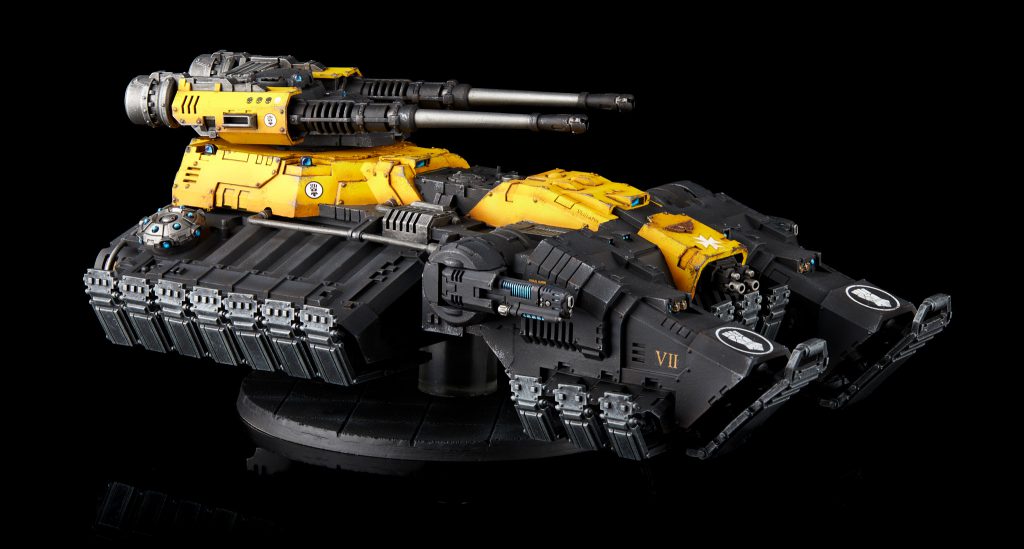
Deploying Large Models
Some large models, typically Aircraft, have wings and other parts that extend significantly beyond their base, this can make it difficult for them to fit wholly within a mission’s deployment zone, and whilst the deployment sequences of mission packs clearly state that no part of the model can overhang the edge of the battlefield, the edge of your deployment zone is not mentioned. For clarity, such models can overhang a deployment zone if it is not possible to set them up otherwise (i.e. if it is not possible to set them up without them overhanging their deployment zone), but when setting them up on the battlefield their base must still be wholly within their deployment zone.
[Core Book FAQ pg.2]
This change is clearly aimed at addressing the controversy over the Orion Gunship, a very large model where on some deployment types, you can fit the base within the deployment zone but not the physical model itself. While there is a pre-existing rule for what to do about models that can’t fit in your deployment zone, it really sucks for the player (the model essentially skips turn 1) and since the Orion measures to the base for rules purposes, some argued that it shouldn’t be subject to this.
It would appear that the designers agree with that, and this rule appears intended to allow the Orion to fly free and cause horrifying carnage to its massive golden heart’s content. However, the way this has been added doesn’t fully close out the confusion here, because this change doesn’t acknowledge the fact that there is already a rule for how to deploy such a model, so it’s not clear when you should use one or the other. Our assumption is that this is only intended to apply to models that measure to base and have hulls that physically protrude beyond that (so mostly Aircraft) but as written there’s no actual reason this wouldn’t apply to the Tesseract Vault too. Some clarity is needed on when you use each rule, and we suspect an “for models that do not measure to their hull” rider will be coming down the line on this one sharpish. That will, of course, be very sad for the Tesseract Vault, leaving it as the only model relevant to 2000pt play that has to eat up the bad version of this on 10” deployment zones.
The other thing to note with this is that this rule only applies when it is impossible to deploy the model otherwise – you can’t overhang the deployment zone just because it’s convenient on the deployment maps where you can fit the model.
Psychic Actions
“While psychic actions are not in and of themselves psychic powers, they function in much the same way. For all intents and purposes, when a unit attempts a psychic action, this is treated the same as if they were attempting to manifest a psychic power, and as such triggers any rules that interact with manifesting a psychic power (e.g. rules that enable you to deny a psychic power can also be used to deny a psychic action). Note that a Psyker can still only attempt to perform one psychic action in their Psychic phase instead of attempting to manifest any other psychic powers.”
[Core Book FAQ pg.2]
We’ve covered this already over in our rundown of the mission changes, but this designers note clarifies that, while Psychic Actions aren’t strictly Psychic Powers, abilities that interact with the process of manifesting a psychic power (most notably various alternative flavours of Deny) can still be used to meddle with them. This mostly gives various armies without Psykers of their own ways to shut down Psychic Actions, and also achieves the always laudable goal of making the rules here work like 95% of people would assume on a first read!
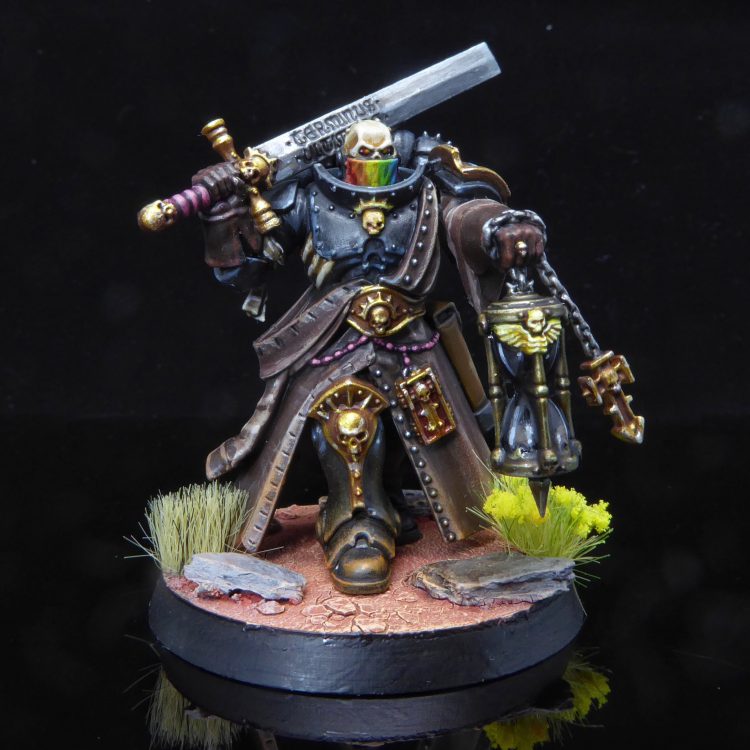
Fight Last: Not Eligible vs Cannot Be Selected
“Pages 361-362 – Rare Rules, Always Fight First/Last Add the following paragraph to the end of this Rare Rules entry: ‘Note that the Counter-offensive Stratagem requires you to select a unit that is eligible to fight. This means that if a unit is under the effects of a rule that says that it is not eligible to fight until after all other eligible units have done so, you will not be able to select that unit to use the Counter-offensive Stratagem.” [Core Book FAQ pg.3]
This emphasises a conclusion that most had already come to, which is that rules that specify they mess with whether a unit is “eligible” to fight do stop them being counter-offensived. As presented here, it does also mean that you need to read “fight last” style effects carefully, because whether they choose to use the word “Eligible” or not does make a small difference to how they function. That’s slightly unusual, since GW are otherwise trying to harmonise how things work in other places. The new Space marine Codex actually has both types of ability, the Whirlwind Supression fire Stratagem uses the “cannot be selected to fight” wording that the Fight First/Last Rare Rule covers. So it’s looking more and more likely that GW intend for their to be abilties that have differing impacts on the fight phase. This is further demonstrated by the newly printed ability for the Silent King: Obeisance Generators, it doesn’t use the “not eligible” wording either. One difference worth mentioning is that Judiciars can only affect a single unit with their ability, so perhaps the feeling is that when a Fight Last can affect multiple units trivially, you should still be able to escape from it with the stratagem.
Repositioning a Unit Causes an Action to Fail
“Page 363 – Rare Rules Repositioned and Replacement Units Add the following point to this box out: ‘9. If that unit was performing an action, that action immediately fails.”[Core Book FAQ pg.3]
Since many re-deploy effects happen in the Psychic Phase, and many Actions care about where you are when you complete the action, it was technically possible for you to start performing an action (mostly Deploy Scramblers) in a nice safe position then have a psyker yeet you across the board to tick off the completion in a hard to to reach spot like your opponent’s deployment zone. While very funny this didn’t seem likely to be intentional, and indeed it turns out not to be.
New Rare Rules
Adding Rare rules is a rules writing mechanic I’m actually very happy to see being utlised, lots of these these things would often have resided in the FAQs of particular factions in 8th and be left for people to find and apply to different issues. Centralising them is a vast improvement and this FAQ provided us some really good ones.
Attacks that Make Multiple Rolls
Some rules, typically weapon abilities, tell you to roll more than one hit roll for each attack made , e.g. ‘each time an attack is made with this weapon, make 2 hit rolls instead of 1’. In these cases, each hit roll is treated as a separate attack that is made against the same target. As such, all normal rules that are triggered by attacks, or that apply to attacks (such as re-rolls or modifiers conferred by other rules) apply to each ‘hit roll’. Note that these additional attacks do not themselves result in more hit rolls being made.
[Core Book FAQ pg.3]
This isn’t really changing everything, because this is how these abilities have always worked and how they were played competitively, but multi-hit roll weapons were a perpetual source of confusion that caused people to semi-regularly tie themselves in knots about exactly how they functioned, so it’s good to have this neatly and unambiguously clarified.
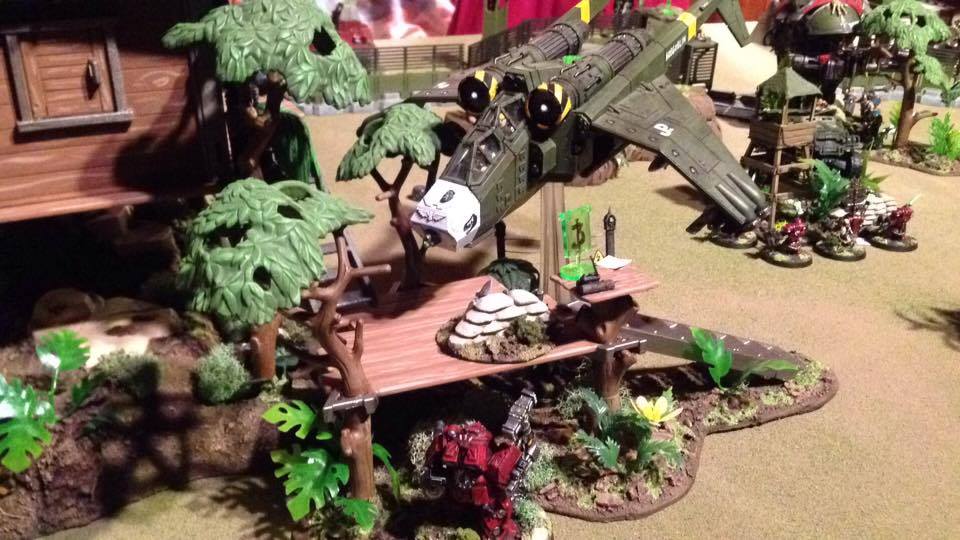
Charging Aircraft
It is not normally possible to end any kind of move within Engagement Range of an enemy Aircraft model. However, many Aircraft models have an ability (e.g. Airborne) that specifically says that they can only be charged by enemy units that can Fly. Such rules take precedence over those in the Core book, and units that can Fly can indeed declare a charge against an Aircraft model, and they can end a charge move within Engagement Range of it. [Core Book FAQ pg.3]
On the one hand, yay they confirmed that Aircraft can be charged by flying units. Any sensible pregame discussion was coming to this conclusion in my opinion and it absolutely still should regardless of what I’m about to say next. They went and tied this rule to the presence of rules such as Airborne. This on the surface might seem fine, it’s when you get to things that have a hover mode rules that it gets silly again.
Hover Jet: Before this model moves in your Movement phase, you can declare it will hover. Its Move characteristic becomes 20″ until the end of the phase, and it loses the Airborne, Hard to Hit and Supersonic abilities until the beginning of your next Movement phase.
By losing Airborne it loses the “such rules” that allow it to be charged. All that being said, forget I pointed this out. It’s really pedantic and if anyone tried to play with this interpretation seriously I would laugh.
Disembarking Large Models
Some models are so large that when they are disembarking from a Transport model it is not possible to set them up wholly within 3″, typically because the disembarking model is itself larger than 3″ in all dimensions. In these cases, set such a model up with its base (or hull) within 1″ of its Transport model’s base (or hull), and not within Engagement Range of any enemy models.
[Core Book FAQ pg.4]
Not too many examples of this, most of the Dreadnoughts a storm raven can carry are on 60mm bases and it’s disembark range measures from it’s base. So they could just about fit in. Perhaps a few of the Tyranid Monsters in a Tyrannocyte though. It’s a pretty sensible change even if it was a rare issue.
Resolving Abilities when Moving off the Edge of the Battlefield
Some models, typically Aircraft, have rules that are used after they have finished making a move in the Movement phase, such as dropping bombs on a unit they have moved over. If a unit has such a rule and it can move off the edge of the battlefield (such as is the case with Aircraft when the Strategic Reserves rule is being used), then for the purposes of those rules, that unit’s move is considered to have finished when it touches the edge of the battlefield; such rules are then resolved, and the model is then removed from the battlefield.
[Core Book FAQ pg.4]
This Rare rule pretty definitively resolves bombing runs by planes that are leaving the board and it does so in a sensible way. It does seem to require that the models resolving abilities are leaving via a board edge though rather than leaving the board via any other directions. Not sure if there are any that might do this but worth mentioning. It does seem to pretty much exclusively cover bombers. A very welcome clarification.

Preventing Reinforcement Units From Setting Up
Some rules prevent Reinforcement units from setting up on certain parts of the battlefield e.g. ‘enemy units that are set up on the battlefield as Reinforcements cannot be set up within 12″ of this unit.’ Such rules always take precedence over rules that instruct you where you can set up Reinforcement units (e.g. ‘in the Reinforcements step of one of your Movement phases you can set up this unit anywhere on the battlefield that is more than 9″ away from any enemy models’. The only exception is units that are arriving from Strategic Reserves that are set up within 1″ of their own battlefield edge and wholly within their own deployment zone – in this case, the Strategic Reserves unit can be so set up, despite any rules enemy models have that would otherwise prevent it from being set up.
[Core Book FAQ pg.4]
This one isn’t too surprising and I think generally most players had come to the conclusion that the ability that says you can’t do something would take precedence, especially when the reinforcement rules don’t say “you can be 9.1” away they say “you must be more than 9” away”. Being 12” away is more than 9”, the unit would still be doing what it’s been told it’s allowed to do. Bit confusing but again these Rare Rules do help to just settle the confusion.
Wings: I think part of the original confusion here stems from people trying to apply “attacker priority” logic to places it doesn’t belong. Also, this is the only possible way this interaction could ever have been meant to work, as otherwise Infiltrators do nothing!
Defensive Rules that Apply to Attacks with Specific Characteristics
Some rules only apply against attacks that have a specific characteristic. For example, ‘Each time an attack with an Armour Penetration characteristic of -1 is allocated to a model in this unit, that attack has an Armour Penetration characteristic of 0 instead.’ Each time you determine if such a rule is triggered, and so applies, always use the modified characteristics of that attack at the Allocate Attack step of the attack sequence. In the example above, that means that if an attack which originally has an Armour Penetration characteristic of 0, but then is modified by another rule before the Allocate Attack step to be -1, then at the Allocate Attack step it would then trigger the ability and be changed back to 0 instead.
[Core Book FAQ pg.4]
I have written about this one a few times and via a set of truly twisted bits of FAQ application, semantics on the wording of “treat as”, and if such wording counts as replacing a characteristic as per the modifying characteristic rules. I think we eventually came to a pretty reasonable stance on these, and I am very happy to say is reflected in this Rare Rule.
Wings: While I think a lot of people were already playing this as above, and like a lot of things Rare Rules address, this is how people would assume the effects to work on a first read, so it’s good to see the game continue to become easier to understand. This does probably work out as a buff to Valorous Heart Sisters, because it means Doctrine-boosted bolter attacks can’t push a point of AP past an Imagifier that ignores AP-2.
Splitting Units with Pre-existing Rules Effects
Some rules enable one unit to split up into two or more smaller units. Each time this happens, any rules that the original unit was being affected by when it split, and which would continue to affect it for a specific duration (from abilities, Stratagems, psychic powers, etc.) continue to affect all of the individual units it split into until such a point as they would normally have no longer applied. For example, if the original unit was within range of an aura ability when it split, any given individual smaller unit would only be affected by that aura ability if it was itself still within range of that ability after the split, whereas if the original unit was being affected by a psychic power that lasted until the end of that turn at the point when it split, all of the smaller individual units would still be affected by it until the end of that turn.
[Core Book FAQ pg.4]
This is an interesting one. Splitting on the board during a battle doesn’t happen too often but splitting before the game isn’t completely uncommon considering how many Space Marine units have Combat squads as an ability. I’ve talked about this before [link] but this Rare rule changes my answer. In the past if you used a stratagem to put a unit into reserves as a reinforcement such as this White Scar one;
Use this Stratagem during the Declare Reserves and Transports step of your mission. Select one WHITE SCARS unit (excluding ARTILLERY and BUILDINGS) from your army. You can set up that unit in outflank instead of setting it up on the battlefield. If you do, at the end of one of your Movement phases you can set up that unit wholly within 6″ of any battlefield edge and more than 9″ away from any enemy models.
My position was that the unit you used it on would no longer exist if you then used the Combat Squads ability to split it into two units. The “this unit” described in the last sentence isn’t either of the two new units Combat Squads created. Meaning they’d be stuck in reserves with no way to enter the board. This Rare Rule however clarifies that stratagems like this would affect both new units until they are deployed and the combination of these abilities would work.
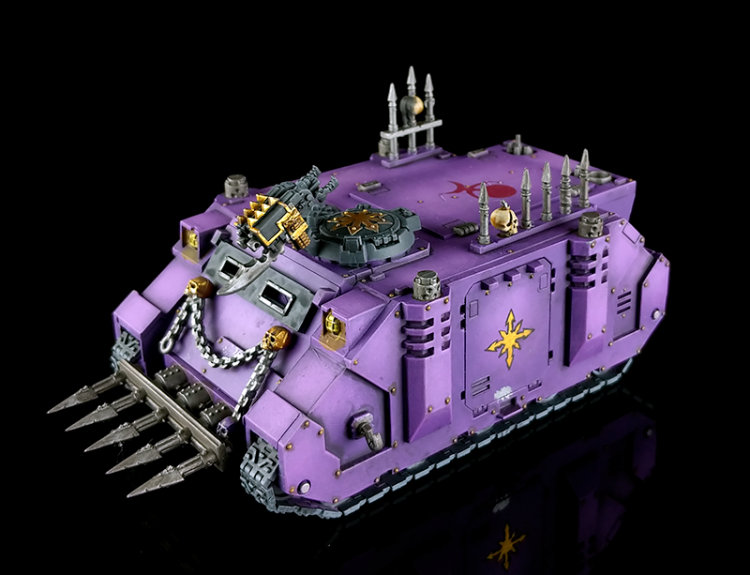
Shooting Whilst Embarked on a Transport
Strap in, because Games Workshop have written a pretty comprehensive Open Topped rule. It took half a page of the FAQ to do it and I think they’ve done a great job, this is a MASSIVE improvement.
Some rules, such as Open-topped, enable units to shoot and make ranged attacks even while embarked within a Transport model. Each time such an embarked unit is selected to shoot, the following rules apply to it:
[Core Book FAQ pg.5 – all following quotes in this section from this page]
Great start so far, some rules do do that, they’ve been confusing for about 3 years and extra confusing for about 6 months (how has it only been 6 months? What is time?)
1. Stratagems cannot be used on that unit in order to affect its attacks, and you cannot use the Command Re-roll Stratagem to affect any dice rolls made for its models’ ranged attacks.
Okay, so you can’t use stratagems on them at all now. That’s fair. I mean I’m still waiting for the day they actually re-write the Command Re-roll Stratagem so that it doesn’t require technically you to slow roll if you might want to use it each phase but I digress.
2. Measure distances and draw line of sight from any point on the Transport model when models in that unit make the ranged attacks.
Yep that makes sense. This also makes them all consistently hull, I think there were some that were base and some that were hull in the past. I know Venoms measure from the hull only for the occupants though which was amusing.
3. If the Transport model made a Normal Move, Advanced, Fell Back or Remained Stationary this turn, embarked units are considered to have done the same when they make ranged attacks.
Yeah not much to say about this. This was pretty much how it was played as far asi know.
4. While the Transport model is within Engagement Range of any enemy units, unless the ability that the Transport model has that allows its passengers to shoot whilst embarked states otherwise, then models in embarked units cannot make ranged attacks, except with Pistols.
This was included as a restriction of sorts in most Open Topped rules, sometimes very specifically. It was a restriction that applied to the vehicle so it would also apply to the units inside.
5. Unless specifically stated otherwise, the embarked unit is not affected by the abilities (including aura abilities) of any other unit, even if that unit is also embarked within the same Transport model.
This one was less obvious. It’s part of Auras that models need to be within, and a model embarked isn’t on the board so it wasn’t within. Having this clearly said is very helpful though. Before you start to worry about defensive aura like abilities read on to point 9!
6. If the unit was under the effects of a rule when it embarked on the Transport model (such as rules bestowed on it during the Command phase, by a psychic power or a Stratagem etc.) those rules do not apply to that unit whilst it is embarked.
Embarking mid game is so infrequently done in my experience, that happening to have this situation actually happen never even crossed my mind. It’s an ambiguity about transports I don’t think I’d ever seen raised that Games Workshop have actually maybe come up with on their own.
7. Any abilities (including Detachment abilities) that models in an embarked unit have, or that their weapons have, continue to apply when they make ranged attacks.
THIS was the really funny one. Even things like overheating and kill yourself is considered a “weapon ability”. Not being affected by any abilities as the rules for 9th say for Embarked Units really led to some ridiculous issues. Infinite Bomb Squiggs, having to roll to hit for Flamers, and more. I don’t think anyone actually played them that way though.
8. If a restriction applies to the Transport model, that same restriction applies to units embarked within it. For example, if the Transport model is not eligible to shoot with because it has Advanced or Fallen Back this turn, its passengers are not eligible to shoot with.
Not really sure this one isn’t a repeat of 3 with the words in a different order if I’m honest.
Wings: I guess there’s a few powers like “target unit can only shoot the closest target” which aren’t solely consequences of moving?
9. If a Transport model is under the effects of a modifier to its ranged attacks (such as a modifier to its hit rolls, wound rolls, etc.) the same modifier applies each time an embarked model makes a ranged attack.
And then finally they resolve the defensive aura-like abilities. Things like -1 to hit outside 12” or just generally defensive abilities. These 100% still affect the units inside the transports, it was for a while in limbo because some of them were auras but auras were said to not work on embarked models. Now we have a clear and concise answer and they work as expected.
Transports and Rules that Count as Remaining Stationary
Some rules allow a model to count as having Remained Stationary, even if that model has moved during its Movement phase. Even if a Transport model is subject to such a rule, embarked models still cannot disembark from that Transport model during the Movement phase if that Transport model has already moved, unless that Transport model (or the models embarked within it) have a rule that explicitly allows them to disembark after the Transport model has moved.
[Core Book FAQ pg.7]
This might almost be the first ever preemptive FAQ I’ve ever read. The most obvious thing it addresses I’m aware of is the new Death Guard ability to always count as “Remain Stationary”. Some argued that this meant you could always disembark from a transport.
I didn’t really think this was a flawless interpretation for a few reasons though.
- Disembarking is not tied to the state of Remaining Stationary, in fact transports aren’t considered Remain Stationary until after the movement phase for most armies. The standard process is that a model starts the phase having not moved, and if you didn’t move for the whole phase then you count as Remain Stationary until your next movement phase.
- If a transport needs to have not moved, then always counting as Remain Stationary would mean the transports could never disembark ever. If it’s like the Death Guard ability and based on the previous movement phase then they could disembark in turn one and then never again.
- If to avoid that you decide that “not moved this turn” and “remain stationary” are equivalent states, then you’ve given Death Guard transports infinite movement from turn 2 onwards. They would *always* meet the criteria of “unit that has not moved this turn” and you could keep selected them over and over.
This Rare Rule closes at least some of these loopholes before they even fully form. Also recognise that the interpretations above are clearly hyperbolic and shouldn’t be taken 100% seriously.
Have any questions or feedback? Got a rules question you want answered? Drop us a note in the comments below, ask a question in our Ruleshammer form, or head over to r/ruleshammer to discuss.
Have any other questions or general feedback? Drop us a note in the comments below or email us at contact@goonhammer.com.
